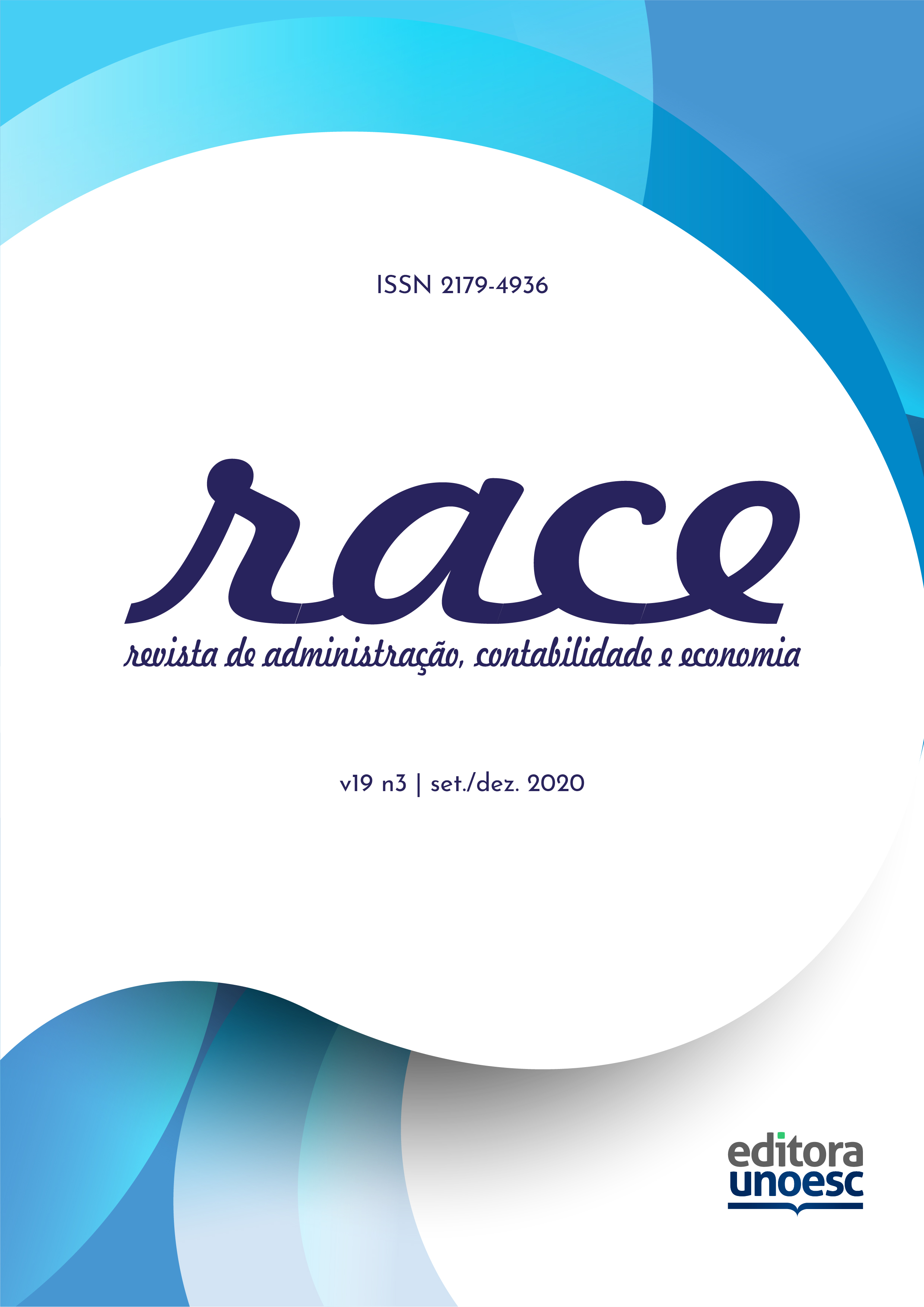Financial leverage, capital structure and the volatility of assets traded on B3
DOI:
https://doi.org/10.18593/race.20845Keywords:
Financial leverage, Volatility and capital structureAbstract
This article aims to measure the effect of financial leverage and capital structure of companies listed on B3 (Brasil, Bolsa, Balcão) on the volatility of their publicly traded Assets. For this, we estimate a panel model with fixed effects using quarterly data and calculate the quarterly volatility through the standard deviation of the daily closing prices of the Assets. The data used includes the quarterly balance sheets during the period from 2010 to the first quarter of 2017 and the price of the assets traded on the stock exchange. The results show that the capital structure of companies influences the volatility of their assets, especially variables such as leverage, composition of the debt and fixed assets. Companies with higher levels of debt are more sensitive to these effects, as are companies in the retail and transportation sector.
Downloads
References
Alaoui, A.O. el, Bacha, O. I. & Masih, M. (2017). Leverage versus volatility: Evidence from the capital structure of European firms. Economic Modelling, 62, 145- 160. Retrieved from https://www.sciencedirect.com/science/article/pii/S0264999316307702?via%3Dihub
https://doi.org/10.1016/j.econmod.2016.11.023
Angrist, J. D., & Pischke, J. S. (2009). Mostly Harmless Econometrics: An Empiricist's Companion. Princeton University Press.
Baker, S. H. (1973). Risk, leverage and profitability: an industry analysis. The Review of Economics and Statistics, 55(4), 503-507. Retrieved from https://www.jstor.org/stable/1925675
Bauer, P. (2004). Determinants of Capital Structure: Empirical evidence from the Czech Republic, Czech. Journal of Economics and Finance, 2-21.
Beakaerta, G., & WU, G. (2000). Asymmetric volatility and risk in equity markets. The Review of Financial Studies, 13, 1–42. Retrieved from https://academic.oup.com/rfs/article-abstract/13/1/1/1584172?redirectedFrom=fulltext https://doi.org/10.1093/rfs/13.1.1
Bouchaud, J. P., Matacz, A., & Potters, M. (2001). The leverage effect in financial markets: retarded volatility and market panic. Physical review letters, 22- 26. Retrieved from https://journals.aps.org/prl/abstract/10.1103/PhysRevLett.87.228701 https://doi.org/10.1103/PhysRevLett.87.228701
Bradley, M., Jarrel, G. A., & Kim, E. H. (1984). On the existence of an optimal capital structure: theory and evidence. The Journal of Finance, 39, 857- 878. Retrieved from
https://doi.org/10.1111/j.1540-6261.1984.tb03680.x
Campbell, J. Y., & Taksler, G. B. (2003). Equity volatility and corporate bond yield. The Journal of Finance, 58, 2321- 2350. Retrieved from https://onlinelibrary.wiley.com/doi/abs/10.1111/j.1540-6261.1984.tb03680.x
https://doi.org/10.1046/j.1540-6261.2003.00607.x
Céspedes, J., González, M., & Molina, C. A. (2010). Ownership and capital structure in Latin America. Journal of Business Research, 63(3), 248- 254. Retrieved from https://www.sciencedirect.com/science/article/abs/pii/S014829630900068X?via%3Dihub
https://doi.org/10.1016/j.jbusres.2009.03.010
Chen, J. J. (2004). Determinants of capital structure of Chinese-listed companies. Journal of Business Research, 57(12), 1341- 1351. Retrieved from https://www.sciencedirect.com/science/article/abs/pii/S0148296303000705?via%3Dihub
https://doi.org/10.1016/S0148-2963(03)00070-5
Choi, J., & Richardson, M. (2016). The Volatility of a firm’s assets and the leverage effect. Journal of Financial Economics, 121(2), 254- 277. Retrieved from https://www.sciencedirect.com/science/article/pii/S0304405X16301003?via%3Dihub
https://doi.org/10.1016/j.jfineco.2016.05.009
Deesomsak, R., Paudyal, K., & Pescetto, G. (2004). The determinants of capital structure: evidence from the Asia Pacic region. Journal of Multinational Financial Management, 14(4-5), 387- 405. Retrieved from https://www.sciencedirect.com/science/article/pii/S1042444X04000039?via%3Dihub
https://doi.org/10.1016/j.mulfin.2004.03.001
Eckbo, B. E., & Norli, Ø. (2005). Liquidity risk, leverage and long-run IPO returns. Forthcoming Journal of Corporate Finance, 11(1-2), 1- 35. Retrieved from https://www.sciencedirect.com/science/article/pii/S0929119904000276?via%3Dihub https://doi.org/10.1016/j.jcorpfin.2004.02.002
Engle, R. F., & NG, V. K. (1993). Measuring and testing the impact of news on volatility. The Journal of Finance, 48(5), 1749- 1778. Retrieved from https://onlinelibrary.wiley.com/doi/full/10.1111/j.1540-6261.1993.tb05127.x
https://doi.org/10.1111/j.1540-6261.1993.tb05127.x
Ericsson, J., Huang, X., & Mazzotta, S. (2016). Leverage and Asymmetric Volatility: The Firm-Level Evidence. Journal of Empirical Finance, 38(A), 1- 21. Retrieved from https://www.sciencedirect.com/science/article/abs/pii/S0927539816300226?via%3Dihub
https://doi.org/10.1016/j.jempfin.2016.02.008
Forte, D., Barros, L. A., & Nakamura, W. T. (2013). Determinants of the Capital Structure of Small and Medium Sized. Brazilian Administration Review, 10(3). Retirado de http://www.scielo.br/scielo.php?script=sci_arttext&pid=S1807-76922013000300007&lng=en&tlng=en
http://dx.doi.org/10.1590/S1807-76922013000300007
Gill, A., Biger, N., & Mathur, N. (2011). The effects of capital structure on profitability: Evidence from United States. International Journal of Management, 28 (4). Retrieved from https://www.researchgate.net/profile/Amarjit_Gill/publication/281004540_The_effects_of_capital_structure_on_profitability_Evidence_from_United_States/links/578768ee08ae78057de18ede.pdf
Johnson, S. A. (2003). Debt maturity and the effects of growth opportunities and liquidity risk on leverage. The Review of Financial Studies, 16(1), 209- 236. Retrieved from https://academic.oup.com/rfs/article-abstract/16/1/209/1616950?redirectedFrom=fulltext
https://doi.org/10.1093/rfs/16.1.0209
Jong, A., Kabir, R., & Nguyen, T. T. (2008). Capital structure around the world: The roles of firm- and country-specific determinants. Journal of Banking & Finance, 32(9), 1954- 1969. Retrieved from https://www.sciencedirect.com/science/article/pii/S0378426608000113?via%3Dihub
https://doi.org/10.1016/j.jbankfin.2007.12.034
Kraus, A., & Litzenberger, R. H. (1973). A state‐preference model of optimal financial leverage. The journal of finance, 28(4), 911- 922. Retrieved from https://onlinelibrary.wiley.com/doi/abs/10.1111/j.1540-6261.1973.tb01415.x https://doi.org/10.1111/j.1540-6261.1973.tb01415.x
Long, L., Tsui, A. K., Zhang, Z. (2014). Conditional heteroscedasticity with leverage effect in stock returns: Evidence from the Chinese stock market. Economic Modelling, 37, 89- 102. Retrieved from https://www.sciencedirect.com/science/article/pii/S0264999313004859?via%3Dihub
https://doi.org/10.1016/j.econmod.2013.11.002
Mesquita, J. M., & Carvalho, L.J. E. (2004). Capital structure and profitability: the Brazilian case. Journal of Finance. Retrieved from http://citeseerx.ist.psu.edu/viewdoc/download?doi=10.1.1.528.6883&rep=rep1&type=pdf
Modigliani, F., & Miller, M. H. (1958). The Cost of capital, corporation finance and the theory of investment. The American Economic Review, 48(3). Retrieved from https://www.jstor.org/stable/1809766?origin=JSTOR-pdf&seq=1#page_scan_tab_contents
Myers, S. C., & Majluf, N. (1984). Corporate financing and investment decisions when firms have information that investors do not have. Journal of Financial Economics, 13(2), 187- 221. Retrieved from https://www.sciencedirect.com/science/article/pii/0304405X84900230?via%3Dihub
https://doi.org/10.1016/0304-405X(84)90023-0
Nelson, D. B. (1991). Conditional heteroskedasticity in asset returns: a new approach. Econometrica, 59(2), 347- 370. Retrieved from https://www.jstor.org/stable/2938260
Neto, A. A. (2015). Estrutura e análise de balanços: um enfoque econômico-financeiro. Atlas.
Rajan, R., & Zingales, L. (1995). What do we know about capital structure? Some evidence from international data. Journal of Finance, 50(5), 1421- 1460. Retrieved from https://onlinelibrary.wiley.com/doi/full/10.1111/j.1540-6261.1995.tb05184.x
https://doi.org/10.1111/j.1540-6261.1995.tb05184.x
Titman, S., & Wessels, R. (1988). The Determinants of Capital Structure Choice. The Journal of Finance, 43(1), 1- 19. Retrieved from
https://onlinelibrary.wiley.com/doi/full/10.1111/j.1540-6261.1988.tb02585.x
https://doi.org/10.1111/j.1540-6261.1988.tb02585.x
Welch, I. (2004). Capital Structure and Stock Returns. Journal of Political Economy, 112(1), 106- 132. Retrieved from https://www.journals.uchicago.edu/doi/10.1086/379933
https://doi.org/10.1086/379933
Published
How to Cite
Issue
Section
License
RACE – Business, Accounting and Economy Journal from Publisher Unoesc is licenced with a Licence Creative Commons – Noncommercial Attribution 4.0 International.



























